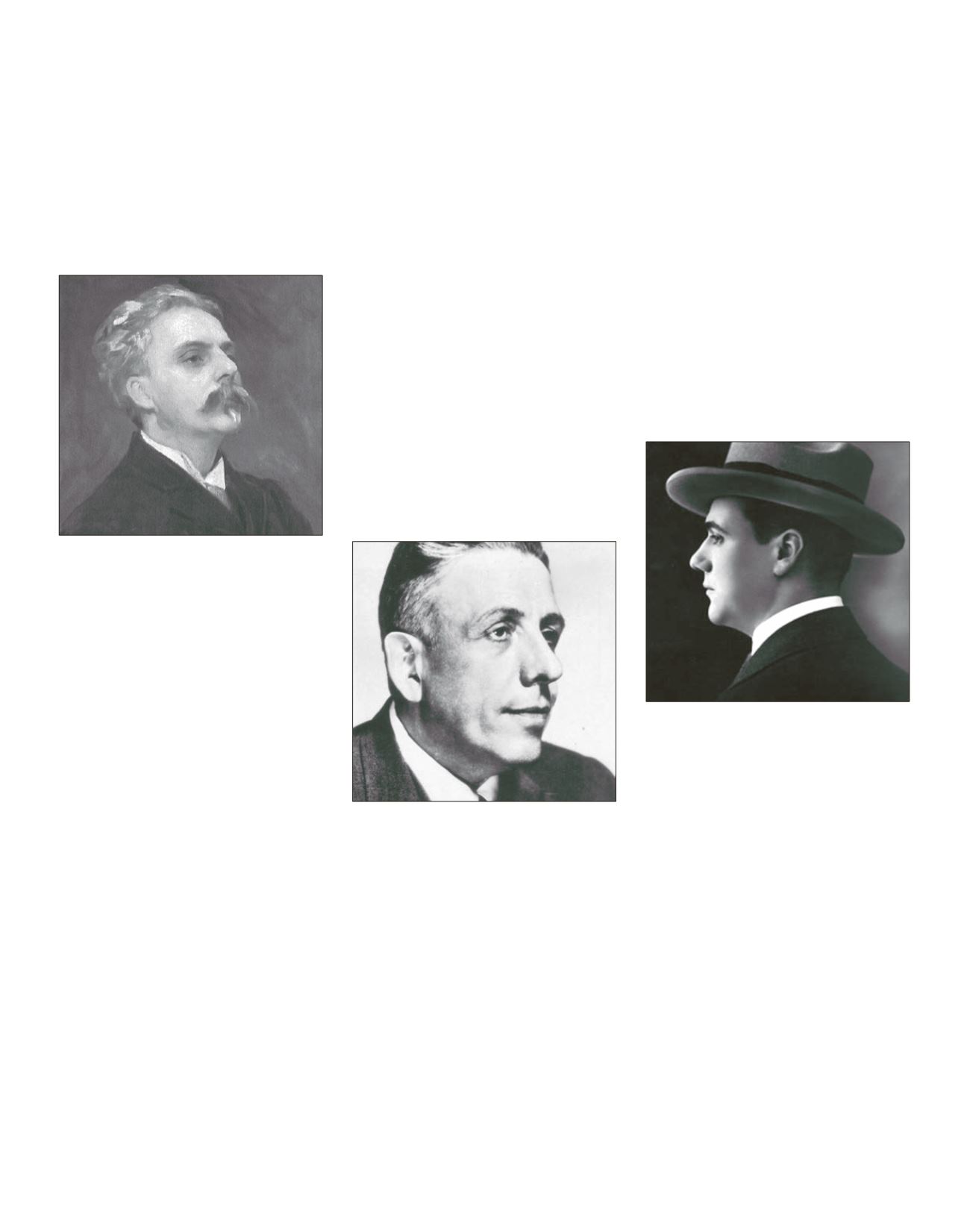
a training school for organists and choirmas-
ters in Paris. Louis Niedermeyer’s conservative
curriculum emphasized counterpoint, organ,
fugue, and chant accompaniment. Fauré’s musi-
cal experience took a radical turn a er Nieder-
meyer’s death in
, when Camille Saint-Saëns
was engaged to teach the piano class. Breaking
with conservative École tradition, Saint-Saëns
introduced students to the “progressive” works
of Schumann, Liszt, and Wagner.
is musi-
cal revelation changed the direction of Fauré’s
composition.
Following graduation (he spent years at the
École Niedermeyer), Fauré worked primarily
as an organist at various churches in Rennes
and Paris. In
, he was appointed assistant
organist at St. Sulpice and later deputized for
Saint-Saëns at the Madeleine.
at same year,
he joined the group of French progressives who
founded the Société National de Musique. Fauré
was named chief organist at the Madeleine and
professor of composition at the Paris Conserva-
tory in
.
In this latter capacity, he was called upon to
compose ute music for the
Concours de
Conservatoire. Invited composers typically pro-
vided the technically demanding test piece as
well as music for sightreading, which appears to
have been the case with Fauré.
e manuscript
of the
Morceau de concours
—a lyrical composi-
tion likely intended for the sightreading portion
(and more accurately titled
Morceau de déchif-
frage
)—was dated July ,
.
at same day, Fauré confessed to his former
mentor Saint-Saëns that he was having di culty
in writing the main test piece (the actual
morceau
de concours
)—the Fantasy, op.
, for ute and
piano. “I can’t remember anything at all that has
given me so much trouble!” Gaston Blanquart,
winner of the ute
concours
, gave the o cial
rst performance of the Fantasy on July ,
.
Fauré dedicated the score to his faculty col-
league, Paul Ta anel, who commissioned all the
ute
concours
pieces during his in uential tenure
as professor at the conservatory ( – ).
FRANCIS POULENC (1899–1963)
Flute Sonata
roughout his formative years as a composer,
Poulenc had personal and musical contacts with
an eclectic group of composers encompassing
the Spanish pianist Ricardo Viñes, the Italians
Alfredo Casella and Gian Francesco Malipiero,
and the Viennese serialist composers Arnold
Schoenberg, Alban Berg, and Anton Webern.
However, the greatest in uence on his emerging
aesthetic was exerted by the loosely allied mem-
bers of Les Six, a group of composers including
Poulenc, who shared the common goal of creat-
ing music devoid of German Romanticism.
Poulenc formulated a highly individual style,
conservative in its harmonic language yet en-
dowed with profoundly expressive lyricism.
is melodic emphasis largely accounts for the
enduring popularity of his vocal and theatrical
compositions: the songs, sacred choral works,
operas, and ballet scores. However, Poulenc was
equally pro cient in small instrumental group-
ings. With the exception of the violin and cello
sonatas and a single movement for guitar, he
wrote primarily for wind instruments in various
combinations.
e sonata for ute and piano was composed
between December
and March
in Pou-
lenc’s apartment at the Hotel Majestic in Cannes
and is dedicated to the memory of the wealthy
American patron of music Elizabeth Sprague
Coolidge. Poulenc accompanied utist Jean-
Pierre Rampal in the premiere on June ,
,
at the Strasbourg Festival.
is sonata imme-
diately earned praise for its resplendent lyrical
beauty, especially in the
Cantilena
.
Clarendon (pen name for Bernard Gavoty),
critic for
Le Figaro
, wrote that Poulenc’s
three-movement ute sonata “ owed from the
heart, without identity, age, or parentage, such
as his music sang in a twofold sense of the term:
a grand melodic rainbow on a blue background
of delicate harmonies. Writing these words I
think above all of the
Cantilena
of the sonata,
which is an airy episode, enchanting, touched
with élan.”
HAMILTON HARTY (1879–1941)
In Ireland
Irish composer and conductor Hamilton Harty
was born in Hillsborough, County Down. He
received early musical instruction in viola, pia-
no, and counterpoint from his father. At age ,
Harty became organist at Magheragall Church
in County Antrim, later holding comparable
posts at St. Barnabas Church (Belfast), Christ
Church (Bray, County Wicklow), and All Saints
Church in Norfolk Square (London). He quickly
established a reputation as composer, accompa-
nist, and conductor in London. During World
War I, Harty regularly conducted the London
Symphony Orchestra and the Hallé Orchestra,
which he served as permanent conductor be-
tween
and
.
On several occasions, Harty toured the United
States as guest conductor, developing an espe-
cially strong relationship with the Chicago Sym-
phony Orchestra. Four universities bestowed
honorary doctorates on him, including DePaul
University ( ). Harty received knighthood in
and the gold medal of the Royal Philhar-
monic Society in
. His compositions can be
grouped into three general categories: program-
matic, o en on Irish themes; classical forms;
and transcriptions. Harty originally conceived
In Ireland
for ute and piano ( ) and later
arranged it for ute, harp, and orchestra ( ).
According to the composer, this programmatic
piece takes place “in a Dublin street at dusk, two
wandering street musicians are playing.”
DAVID OVERTON (b. 1942), arr.
Irish Folk Songs
David Overton’s services as an arranger and
composer are in great demand by performers
such as the King’s Singers and utist Sir James
Galway. His special creations for Galway include
Gabriel Fauré by John Singer Sargent (1889)
Francis Poulenc
Hamilton Harty
6(PT(0%(R ɰ 6(PT(0%(R
_ R$9,1,$ 0$*$=,1(
103








